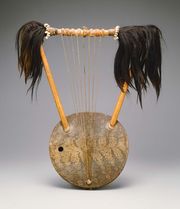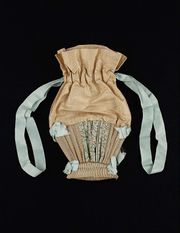Difference between revisions of "Animal fibers"
Jump to navigation
Jump to search
| (8 intermediate revisions by the same user not shown) | |||
| Line 1: | Line 1: | ||
| + | [[File:Bowl Lyre MFA.jpg|thumb|Bowl lyre (ndongo)<br>MFA# 17.2179]] | ||
| + | [[File:Drawstring bag MFA.jpg|thumb|Drawstring bag <br>MFA# 52.454]] | ||
== Description == | == Description == | ||
| − | Any fiber obtained from animal sources. Examples are [[ | + | Any fiber obtained from animal sources. Examples are [[alpaca|Alpaca]], [[angora|Angora]], [[Camel hair|Camel]], [[cashmere]], [[mohair|mohair]], [[silk|Silk]], [[vicuna]], and [[wool|wool]]. In general, animal fibers do not burn as readily as [[plant fiber|vegetable fibers]]. Instead, animal fibers tend to char and emit mildly nitrogenous odors characteristic of burnt hair. Except for silk, all animal fibers can be microscopically characterized by their tiny surface scales and center shaft ([[cortex|cortex]]). |
| + | |||
| + | See [http://cameo.mfa.org/wiki/Fiber_Reference_Image_Library FRIL] for microscopic images of [http://cameo.mfa.org/wiki/Category:FRIL:_Animal_Fibers animal fibers.] | ||
== Synonyms and Related Terms == | == Synonyms and Related Terms == | ||
| Line 7: | Line 11: | ||
animal fibres (Br.); fibras animales (Esp.); fibre animale (Fr.); dierlijke vezels (Ned); | animal fibres (Br.); fibras animales (Esp.); fibre animale (Fr.); dierlijke vezels (Ned); | ||
| − | == | + | == Physical and Chemical Properties == |
| − | + | * Does not burn readily. | |
| − | + | * Dissolves in strong alkalis. | |
| − | + | * Fibers have tiny surface scales and center shaft | |
| − | |||
| − | |||
| − | |||
| − | |||
== Comparisons == | == Comparisons == | ||
| Line 21: | Line 21: | ||
[[media:Properties of Natural Fibers.pdf|Properties of Natural Fibers]] | [[media:Properties of Natural Fibers.pdf|Properties of Natural Fibers]] | ||
| − | == | + | ==Resources and Citations== |
| + | * Wikipedia: https://en.wikipedia.org/wiki/Animal_fiber (Accessed October 13, 2020) | ||
| + | |||
| + | * M.Goodway "Fiber Identification in Practice" JAIC 26:27-44, 1987. [http://aic.stanford.edu/jaic/articles/jaic26-01-003_indx.html LINK] | ||
* Hoechst Celanese Corporation, ''Dictionary of Fiber & Textile Technology'' (older version called Man-made Fiber and Textile Dictionary, 1965), Hoechst Celanese Corporation, Charlotte NC, 1990 | * Hoechst Celanese Corporation, ''Dictionary of Fiber & Textile Technology'' (older version called Man-made Fiber and Textile Dictionary, 1965), Hoechst Celanese Corporation, Charlotte NC, 1990 | ||
Latest revision as of 08:39, 14 October 2020
Description
Any fiber obtained from animal sources. Examples are Alpaca, Angora, Camel, Cashmere, Mohair, Silk, Vicuna, and Wool. In general, animal fibers do not burn as readily as vegetable fibers. Instead, animal fibers tend to char and emit mildly nitrogenous odors characteristic of burnt hair. Except for silk, all animal fibers can be microscopically characterized by their tiny surface scales and center shaft (Cortex).
See FRIL for microscopic images of animal fibers.
Synonyms and Related Terms
animal fibres (Br.); fibras animales (Esp.); fibre animale (Fr.); dierlijke vezels (Ned);
Physical and Chemical Properties
- Does not burn readily.
- Dissolves in strong alkalis.
- Fibers have tiny surface scales and center shaft
Comparisons
Resources and Citations
- Wikipedia: https://en.wikipedia.org/wiki/Animal_fiber (Accessed October 13, 2020)
- M.Goodway "Fiber Identification in Practice" JAIC 26:27-44, 1987. LINK
- Hoechst Celanese Corporation, Dictionary of Fiber & Textile Technology (older version called Man-made Fiber and Textile Dictionary, 1965), Hoechst Celanese Corporation, Charlotte NC, 1990
- S.R.Trotman, E.R. Trotman, Textile Analysis, J.B. Lippincott Company, Philadelphia, 1932

